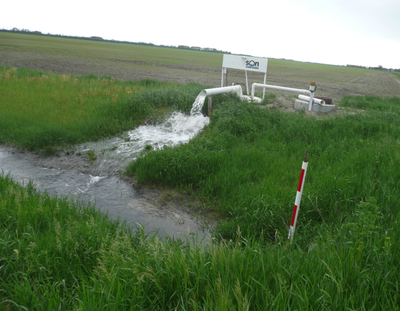Subsurface (Tile) Drainage in North Dakota and the Red River Valley
 Subsurface drainage can be described as buried pipelines that intercept water below ground surface and direct it to an outlet. Subsurface drainage is often referred to as "tile" drainage because up to the 1970's, clay or concrete tiles were used to construct the subsurface pipeline. The joints between the tiles allowed water to flow into the pipeline. Since the 1970's, most tile drainage uses corrugated plastic pipe that is perforated. Many homes with basements have plastic tile lines installed around the footings to control basement water seepage. In agriculture, tile drainage is used to control water table elevations in production fields. Many agricultural fields have areas where the water table rises close to the surface before, during or after the growing season. This water is generally not removed in a timely manner by surface drains. To control the water table, farmers install tile lines below the surface to intercept the water and direct it off the field. Tile lines are commonly buried 3 to 4 feet below the surface to allow normal tillage or planting operations and promote full root development of the crop. The tile lines, 3, 4 or 5 inches in diameter, are called laterals and many laterals may be connected to a larger diameter sub-mains or a main delivery pipe to convey water to the outlet. A tiled field may have one or more outlet locations depending on topography and surface drainage in the area. In some places, the elevation of the outlet is higher than the elevation of the main and a pump station must be used to lift the water from the main to the surface drain.
Subsurface drainage can be described as buried pipelines that intercept water below ground surface and direct it to an outlet. Subsurface drainage is often referred to as "tile" drainage because up to the 1970's, clay or concrete tiles were used to construct the subsurface pipeline. The joints between the tiles allowed water to flow into the pipeline. Since the 1970's, most tile drainage uses corrugated plastic pipe that is perforated. Many homes with basements have plastic tile lines installed around the footings to control basement water seepage. In agriculture, tile drainage is used to control water table elevations in production fields. Many agricultural fields have areas where the water table rises close to the surface before, during or after the growing season. This water is generally not removed in a timely manner by surface drains. To control the water table, farmers install tile lines below the surface to intercept the water and direct it off the field. Tile lines are commonly buried 3 to 4 feet below the surface to allow normal tillage or planting operations and promote full root development of the crop. The tile lines, 3, 4 or 5 inches in diameter, are called laterals and many laterals may be connected to a larger diameter sub-mains or a main delivery pipe to convey water to the outlet. A tiled field may have one or more outlet locations depending on topography and surface drainage in the area. In some places, the elevation of the outlet is higher than the elevation of the main and a pump station must be used to lift the water from the main to the surface drain.
Farmers install tile drainage to control high water table situations that affect planting, cultivation or harvest conditions and/or remove excess salt that accumulates in the soil. In the semi-arid and arid portions of the country, salt accumulation inhibits crop production and is often linked to rising water table conditions either due to natural rain events or irrigation. Salt accumulation frequently affects the selection of crops that can be grown on a field, so a farmer may decide to tile a field to improve their crop rotation.
1. Frequently Asked Questions about Subsurface Drainage
2. Online Training Modules for Drainage Water Management
3. Water Quality of Tile Water in the Red River Valley
4. Drainage Calculators - Online
5. Tile Drainage Pump Stations for Farm Fields
6. Safely Installing Drain Tile in Fields with Buried Pipelines.

